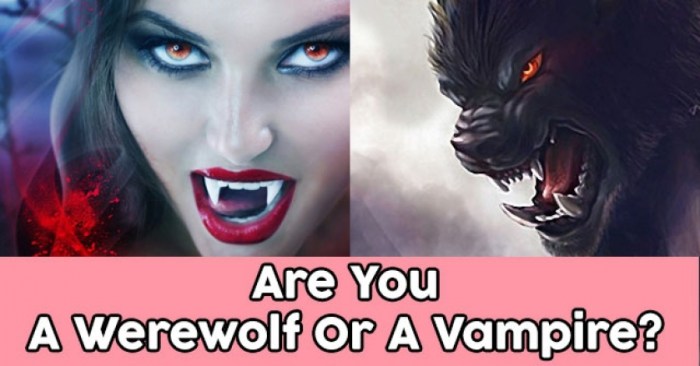Am I a vampire or werewolf? This enigmatic question has captivated imaginations for centuries, fueling countless tales of supernatural intrigue. From the bloodthirsty fangs of vampires to the primal instincts of werewolves, these creatures have become deeply embedded in our cultural consciousness.
In this exploration, we embark on a journey to unravel the mysteries surrounding these iconic beings, examining their physiological characteristics, behavioral patterns, origins, cultural impact, and even delving into medical conditions that may resemble their traits.
The realm of vampires and werewolves is a tapestry woven with both scientific intrigue and folkloric enchantment. Their physical attributes, such as pale skin and heightened senses for vampires, and the transformation into a wolf-like creature under the full moon for werewolves, have captivated our imaginations.
We will delve into the scientific basis behind these characteristics, exploring the physiological and psychological factors that shape their existence.
Physiological Characteristics

Vampires and werewolves are often depicted with distinct physical traits that set them apart from humans. Vampires are typically described as having pale skin, sharp fangs, and a thirst for blood, while werewolves are known for their ability to transform into wolves or wolf-like creatures.
These physical characteristics have a basis in folklore and popular culture. In vampire lore, the pale skin is said to be a result of their nocturnal lifestyle, while the sharp fangs are used for piercing the skin of their victims.
Werewolves, on the other hand, are often depicted with fur, claws, and a heightened sense of smell, all of which are adaptations that would be beneficial for hunting in the wild.
While some of these physical characteristics may have a scientific basis, it is important to note that vampires and werewolves are mythical creatures and do not exist in reality. The physical traits associated with these creatures are simply a product of human imagination and storytelling.
Behavioral Patterns
Vampires and werewolves are also known for their distinct behavioral patterns. Vampires are often depicted as being nocturnal, secretive, and predatory, while werewolves are known for their aggression, loyalty, and pack mentality.
These behavioral patterns can be explained by the psychological and social factors that influence these creatures. Vampires, for example, are often depicted as being loners who are driven by their thirst for blood. This behavior can be seen as a metaphor for the human desire for power and control.
Werewolves, on the other hand, are often depicted as being social creatures who are loyal to their pack. This behavior can be seen as a metaphor for the human need for community and belonging.
It is important to note that the behavioral patterns associated with vampires and werewolves are not fixed. These creatures can exhibit a wide range of behaviors, depending on their individual personalities and circumstances.
Origins and Mythology

The origins of vampire and werewolf myths can be traced back to ancient cultures around the world. Vampires, for example, are thought to have originated in Eastern European folklore, while werewolves are thought to have originated in ancient Greece. Over time, these myths have evolved and spread to different parts of the world, taking on different forms and meanings.
One of the common themes found in vampire and werewolf stories is the idea of the outsider. Vampires are often depicted as being outsiders who are feared and mistrusted by society. Werewolves, on the other hand, are often depicted as being outsiders who are both feared and respected.
These themes of the outsider can be seen as a reflection of the human experience. Vampires and werewolves represent the fears and anxieties that we have about those who are different from us. They also represent the desire to be accepted and to belong.
Cultural Impact
Vampire and werewolf lore has had a profound impact on popular culture. These creatures have been featured in countless books, movies, and television shows. They have also been used as symbols in art, music, and fashion.
The cultural impact of vampire and werewolf lore can be seen in the way that these creatures have been used to represent different aspects of the human experience. Vampires, for example, have been used to represent the dangers of addiction and the desire for immortality.
Werewolves, on the other hand, have been used to represent the power of nature and the struggle between good and evil.
Vampire and werewolf lore continues to be a source of fascination for people around the world. These creatures represent our fears, our desires, and our hopes for the future.
Medical Conditions: Am I A Vampire Or Werewolf

There are a number of medical conditions that can resemble vampire or werewolf characteristics. For example, the condition known as porphyria can cause symptoms such as pale skin, sensitivity to sunlight, and a thirst for blood. The condition known as hypertrichosis can cause excessive hair growth, which can give a person a werewolf-like appearance.
It is important to note that these medical conditions are very rare. They do not cause people to become vampires or werewolves. However, they can lead to misinterpretations and cultural myths.
If you are experiencing any symptoms that resemble vampire or werewolf characteristics, it is important to see a doctor to rule out any underlying medical conditions.
FAQ Explained
What are the key differences between vampires and werewolves?
Vampires are undead creatures that feed on blood, while werewolves are humans who transform into wolves during the full moon. Vampires possess supernatural abilities such as enhanced strength, speed, and the ability to mesmerize, while werewolves gain heightened senses, increased agility, and a heightened sense of aggression.
Can vampires and werewolves coexist peacefully?
In folklore and popular culture, vampires and werewolves are often depicted as enemies. However, there have been instances where they have formed alliances or even romantic relationships. The possibility of peaceful coexistence depends on the specific portrayal and interpretation of these creatures within a given narrative.
Are there any medical conditions that resemble vampire or werewolf characteristics?
Certain medical conditions, such as porphyria and hypertrichosis, can exhibit symptoms that may resemble vampire or werewolf traits. Porphyria can cause skin sensitivity to sunlight, while hypertrichosis leads to excessive hair growth. However, it is important to note that these conditions are not supernatural in nature and can be medically treated.
